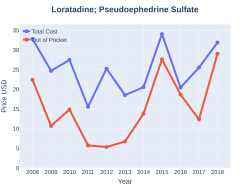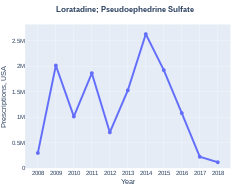Pseudoephedrine/loratadine
| Combination of | |
|---|---|
| Pseudoephedrine | Sympathomimetic |
| Loratadine | H1 antagonist |
| Names | |
| Trade names | Claritin-D, Clarinase |
| Clinical data | |
| Pregnancy category |
|
| Routes of use | Oral |
| External links | |
| AHFS/Drugs.com | claritin-d |
| Legal | |
| Legal status |
|
Pseudoephedrine/loratadine (trade name Claritin-D, Clarinase) is an orally administered combination drug used for the treatment of allergic rhinitis and the common cold[1][2]. This drug can be bought "over the counter" in some countries (United States, Hong Kong), but it is restricted to prescription in others (Czech Republic, Israel).
- Pseudoephedrine, one of the naturally occurring alkaloids of ephedra, is a sympathomimetic used as a decongestant. It produces a decongestant effect that is facilitated by the vasoconstriction in the mucosal capillaries of the upper respiratory areas.
- Loratadine is a long-acting antihistamine (H1 histamine antagonist) that is less sedating than older substances of its type.
Medical uses
Pseudoephedrine/loratadine are indicated for the relief of symptoms associated with allergic rhinitis and the common cold including nasal congestion, sneezing, rhinorrhea, pruritus and lacrimation.
Composition
Clarinase Repetabs
A Clarinase Repetab tablet contains 5 mg loratadine in the tablet coating and 120 mg pseudoephedrine sulfate equally distributed between the tablet coating and the barrier-coated core. The two active components in the coating are quickly liberated; release of pseudoephedrine in the core is delayed for several hours.
Interactions, adverse effects and contraindications
Interactions, adverse effects and contraindications are described in more detail in the articles about pseudoephedrine and loratadine.
Interactions
When sympathomimetics are given to patients receiving monoamine oxidase inhibitors (MAO inhibitors), hypertensive reactions, including hypertensive crises may occur.
Side effects
During controlled clinical studies with the recommended dosage, the incidence of adverse effects was comparable to that of placebo, with the exception of insomnia and dry mouth, both of which were commonly reported.
Contraindications
Clarinase is contraindicated in patients receiving MAO inhibitor therapy or within 14 days of discontinuing such treatment and in patients with narrow angle glaucoma, urinary retention, severe hypertension, severe coronary artery disease and hyperthyroidism.
Society and culture
Cost
This medication has a cost in the U.S. of $15 (USD) for 10 tablets, extended release 10 mg-240 mg[3]
-
Pseudoephedrine/loratadine costs (US)
-
Pseudoephedrine/loratadine prescriptions (US)
References
- ↑ "Clarinase repetabs" (PDF). Ministry of Health Il. Archived (PDF) from the original on 29 August 2021. Retrieved 3 April 2021.
- ↑ "Claritin-D: Uses, Dosage, Side Effects". Drugs.com. Archived from the original on 9 March 2021. Retrieved 3 April 2021.
- ↑ "Loratadine/pseudoephedrine Prices, Coupons & Patient Assistance Programs". Drugs.com. Archived from the original on 15 January 2021. Retrieved 3 April 2021.
External links
| Identifiers: |
|
|---|
- Pages using duplicate arguments in template calls
- Chemical articles with unknown parameter in Infobox drug
- Chemical articles without CAS registry number
- Articles without EBI source
- Chemical pages without ChemSpiderID
- Chemical pages without DrugBank identifier
- Articles without KEGG source
- Articles without InChI source
- Articles without UNII source
- Drugs missing an ATC code
- Drugs that are a combination of chemicals
- H1 receptor antagonists
- Decongestants
- Combination drugs

